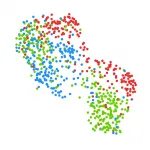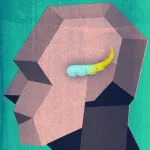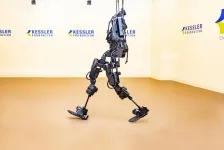(Press-News.org) WACO, Texas (May 28, 2021) - About 36 million people have blindness including 1 million children. Additionally, 216 million people experience moderate to severe visual impairment. However, STEM (science, technology, engineering and math) education maintains a reliance on three-dimensional imagery for education. Most of this imagery is inaccessible to students with blindness. A breakthrough study by Bryan Shaw, Ph.D., professor of chemistry and biochemistry at Baylor University, aims to make science more accessible to people who are blind or visually impaired through small, candy-like models.
The Baylor-led study, published May 28 in the journal Science Advances, uses millimeter-scale gelatin models -- similar to gummy bears -- to improve visualization of protein molecules using oral stereognosis, or visualization of 3D shapes via the tongue and lips. The goal of the study was to create smaller, more practical tactile models of 3D imagery depicting protein molecules. The protein molecules were selected because their structures are some of the most numerous, complex and high-resolution 3D images presented throughout STEM education.
"Your tongue is your finest tactile sensor -- about twice as sensitive as the finger tips -- but it is also a hydrostat, similar to an octopus arm. It can wiggle into grooves that your fingers won't touch, but nobody really uses the tongue or lips in tactile learning. We thought to make very small, high-resolution 3D models, and visualize them by mouth," Shaw said.
The study included 396 participants in total -- 31 fourth- and fifth-graders as well as 365 college students. Mouth, hands and eyesight were tested at identifying specific structures. All students were blindfolded during the oral and manual tactile model testing.
Each participant was given three minutes to assess or visualize the structure of a study protein with their fingertips, followed by one minute with a test protein. After the four minutes, they were asked whether the test protein was the same or a different model than the initial study protein. The entire process was repeated using the mouth to discern shape instead of the fingers.
Students recognized struc¬tures by mouth at 85.59% accuracy, similar to recognition by eyesight using computer animation. Testing involved identical edible gelatin models and nonedible 3D-printed models. Gelatin models were correctly identified at rates comparable to the nonedible models.
"You can visualize the shapes of these tiny objects as accurately by mouth as by eyesight. That was actually surprising," Shaw said.
The models, which can be used for students with or without visual impairment, offer a low-cost, portable and convenient way to make 3D imagery more accessible. The methods of the study are not limited to molecular models of protein structures -- oral visualization could be done with any 3D model, Shaw said.
Additionally, while gelatin models were the only edible models tested, Shaw's team created high-resolution models from other edible materials, including taffy and chocolate. Certain surface features of the models, like a proteins pattern of positive and negative surface charge, could be represented using different flavor patterns on the model.
"This methodology could be applied to images and models of anything, like cells, organelles, 3D surfaces in math or 3D pieces of art -- any 3D rendering. It's not limited to STEM, but useful for humanities too," said Katelyn Baumer, doctoral candidate and lead author of the study.
Shaw's lab sees oral visualization through tiny models as a beneficial addition to the multisensory learning tools available for students, particularly those with extraordinary visual needs. Models like the ones in this study can make STEM more accessible to students with blindness or visual impairment.
"Students with blindness are systematically excluded from chemistry, and much of STEM. Just look around our labs and you can see why -- there is Braille on the elevator button up to the lab and Braille on the door of the lab. That's where accessibility ends. Baylor is the perfect place to start making STEM more accessible. Baylor could become an oasis for people with disabilities to learn STEM," Shaw said.
Shaw isn't new to high-profile research related to visual impairment. He has received recognition for his work on the White Eye Detector app. Shaw and Greg Hamerly, Ph.D., associate professor of computer science at Baylor, built the mobile app which serves as a tool for parents to screen for pediatric eye disease. Shaw's inspiration for the app came after his son, Noah, was diagnosed with retinoblastoma at four months of age.
INFORMATION:
ABOUT BAYLOR UNIVERSITY
Baylor University is a private Christian University and a nationally ranked research institution. The University provides a vibrant campus community for more than 19,000 students by blending interdisciplinary research with an international reputation for educational excellence and a faculty commitment to teaching and scholarship. Chartered in 1845 by the Republic of Texas through the efforts of Baptist pioneers, Baylor is the oldest continually operating University in Texas. Located in Waco, Baylor welcomes students from all 50 states and more than 90 countries to study a broad range of degrees among its 12 nationally recognized academic divisions.
Five researchers shed new light on a key argument to reduce greenhouse gases (GHG): they provided the first economic analysis of conversion factors of other GHG like methane into their CO2 equivalent in overshoot scenarios. Although the United Nations Framework Convention on Climate Change (UNFCCC) considers settling for one value of reference (known as "Common Metric") to make this conversion among the Paris Agreement, the models presented here show the economic advantage of flexibility between various factors of conversion. "A key notion in the UNFCCC is to reduce GHG emissions in the least costly way so as to ensure global benefits" highlights Katsumasa Tanaka, primary author of the Science Advances study.
The research provides series of dynamic variations of ...
A study coordinated by Luís Graça, principal investigator at the Instituto de Medicina Molecular João Lobo Antunes (iMM; Portugal) and Professor at the Faculty of Medicine of the University of Lisbon (FMUL) used lymph nodes, tonsils and blood, to show how the cells that control production of antibodies are formed and act. The results published now in the scientific journal Science Immunology* unveiled key aspects about the regulation of antibody production, with significant importance for diseases where antibody production is dysregulated such as autoimmune diseases or allergies.
In the last few ...
A new study of dozens of wild fish species commonly consumed in the Peruvian Amazon says that people there could suffer major nutritional shortages if ongoing losses in fish biodiversity continue. Furthermore, the increasing use of aquaculture and other substitutes may not compensate. The research has implications far beyond the Amazon, since the diversity and abundance of wild-harvested foods is declining in rivers and lakes globally, as well as on land. Some 2 billion people globally depend on non-cultivated foods; inland fisheries alone employ some 60 million people, and provide the primary source of protein for some 200 million. The study appears this week in the journal Science Advances.
The ...
Centuries-old smoke particles preserved in the ice reveal a fiery past in the Southern Hemisphere and shed new light on the future impacts of global climate change, according to new research published in Science Advances.
"Up till now, the magnitude of past fire activity, and thus the amount of smoke in the preindustrial atmosphere, has not been well characterized," said Pengfei Liu, a former graduate student and postdoctoral fellow at the Harvard John A. Paulson School of Engineering and Applied Sciences (SEAS) and first author of the paper. "These results have importance for understanding the evolution of climate change from the 1750s until ...
Since the onset of the CRISPR genetic editing revolution, scientists have been working to leverage the technology in the development of gene drives that target pathogen-spreading mosquitoes such as Anopheles and Aedes species, which spread malaria, dengue and other life-threatening diseases.
Much less genetic engineering has been devoted to Culex genus mosquitoes, which spread devastating afflictions stemming from West Nile virus--the leading cause of mosquito-borne disease in the continental United States--as well as other viruses such as the Japanese encephalitis virus (JEV) and the pathogen causing avian malaria, a threat to ...
DALLAS - May 28, 2021 - A study of gene activity in the brain's hippocampus, led by UT Southwestern researchers, has identified marked differences between the region's anterior and posterior portions. The END ...
East Hanover, NJ. May 28, 2021. A team of researchers has shown that physical intervention plans that included exoskeleton-assisted walking helped people with spinal cord injury evacuate more efficiently and improved the consistency of their stool. This finding was reported in Journal of Clinical Medicine on March 2, 2021, in the article "The Effect of Exoskeletal-Assisted Walking on Spinal Cord Injury Bowel Function: Results from a Randomized Trial and Comparison to Other Physical Interventions" (doi: 10.3390/jcm10050964).
The authors are Peter H. Gorman, MD, of the University of Maryland School of Medicine, Gail F. Forrest, PhD, of Kessler Foundation's Tim and Caroline Reynolds Center for Spinal Stimulation, Dr. William Scott, of VA Maryland Healthcare System, ...
Neurological disorders such as Parkinson's disease and epilepsy have had some treatment success with deep brain stimulation, but those require surgical device implantation. A multidisciplinary team at Washington University in St. Louis has developed a new brain stimulation technique using focused ultrasound that is able to turn specific types of neurons in the brain on and off and precisely control motor activity without surgical device implantation.
The team, led by Hong Chen, assistant professor of biomedical engineering in the McKelvey School of Engineering and of radiation oncology at the School of Medicine, is the first to provide direct evidence showing noninvasive, cell-type-specific ...
Corals are in trouble. All across the globe the diverse and dynamic ecosystems are taking huge hits year after year. The Great Barrier Reef has lost half of its coral since 1995. Scientists are seeing similar declines in reefs from Hawai'i to the Florida Keys and across the Indo-Pacific region.
The widespread decline is fueled in part by climate-driven heatwaves that induce coral bleaching -- the breakdown of the relationship between shallow-water coral and the symbiotic algae they rely upon for nutrients.
Climate change is a clear and present danger to the persistence of coral reefs, and global reductions in carbon emissions is ...
East Hanover, NJ. May 28, 2021. A team of multiple sclerosis (MS) experts at Kessler Foundation led the first pilot randomized controlled trial of robotic-exoskeleton assisted exercise rehabilitation (REAER) effects on mobility, cognition, and brain connectivity in people with substantial MS-related disability. Their results showed that REAER is likely an effective intervention, and is a promising therapy for improving the lives of those with MS.
The article, "A pilot randomized controlled trial of robotic exoskeleton-assisted exercise rehabilitation in multiple sclerosis," (doi: 10.1016/j.msard.2021.102936) was published on April 4, 2021, by Multiple Sclerosis and Related Disorders. It is available open access at https://www.msard-journal.com/article/S2211-0348(21)00203-0/fulltext.
The ...






